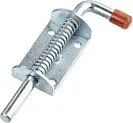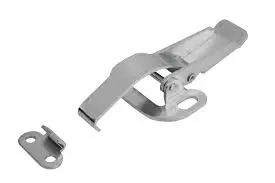What are the Different Types of Latch Spring Pulls?
2025-03-18 15:04:11
Latch spring pulls are essential components in various mechanical systems, serving as crucial elements for securing and releasing mechanisms in doors, cabinets, and industrial equipment. These versatile devices combine the functionality of a latch mechanism with the convenience of a spring-loaded pull handle, offering both security and ease of access. Understanding the different types of latch spring pulls is vital for selecting the right component for specific applications, as each type offers unique features and benefits suited to different use cases.

How Do Different Materials Impact Latch Spring Pull Performance?
Stainless Steel Latch Spring Pulls
Stainless steel latch spring pulls represent the gold standard in durability and corrosion resistance. These components are engineered to withstand harsh environmental conditions while maintaining their structural integrity and operational efficiency. The inherent properties of stainless steel, including its high tensile strength and resistance to oxidation, make it particularly suitable for outdoor applications and environments exposed to moisture or chemical agents. In marine applications, stainless steel latch spring pulls have demonstrated exceptional longevity, with some models maintaining their functionality for decades with minimal maintenance requirements. The material's natural resistance to bacterial growth also makes it ideal for use in medical and food processing facilities.
Zinc Alloy Latch Spring Pulls
Zinc alloy latch spring pulls offer an excellent balance between cost-effectiveness and performance. These components undergo a die-casting process that allows for complex designs while maintaining structural integrity. The material's natural properties provide good resistance to corrosion, though not as extensive as stainless steel. Zinc alloy latch spring pulls are particularly popular in automotive applications due to their favorable weight-to-strength ratio and ability to withstand repeated use cycles. The material also accepts various surface treatments and finishes, allowing manufacturers to enhance both aesthetic appeal and durability through processes like chrome plating or powder coating.
Composite Material Latch Spring Pulls
Modern composite materials have revolutionized the latch spring pull industry by offering lightweight alternatives that don't compromise on strength. These components typically incorporate high-grade polymers reinforced with glass or carbon fibers, resulting in products that resist both chemical degradation and physical wear. Composite latch spring pulls excel in applications where weight reduction is crucial, such as aerospace and high-performance automotive systems. The material's natural insulating properties also make it ideal for applications where electrical isolation is required, providing an additional safety feature that metallic alternatives cannot match.
What Are the Key Installation Considerations for Latch Spring Pulls?
Mounting Surface Requirements
The effectiveness of a latch spring pull largely depends on proper installation on an appropriate mounting surface. The surface must possess sufficient structural integrity to support both the weight of the latch mechanism and the forces applied during operation. Professional installers recommend a minimum material thickness for different applications, with metal surfaces typically requiring at least 2mm thickness for optimal performance. The mounting surface should be clean, flat, and free from distortions that could affect the latch's alignment. Additionally, consideration must be given to the surrounding structure to ensure adequate clearance for the pull's full range of motion.
Alignment and Spacing Specifications
Precise alignment is crucial for optimal latch spring pull operation. The installation process must account for both vertical and horizontal alignment to ensure smooth engagement and release of the latch mechanism. Industry standards typically specify maximum tolerance levels for misalignment, usually not exceeding 1.5mm in any direction. The spacing between multiple latch spring pulls, when used in conjunction, must also be carefully considered to prevent interference while maintaining security. Proper spacing ensures even distribution of load and prevents premature wear on individual components.
Environmental Protection Measures
Installing latch spring pulls in challenging environments requires additional protective measures to ensure long-term reliability. This includes selecting appropriate gaskets and seals to prevent moisture ingress, particularly in outdoor or high-humidity applications. The installation process should incorporate proper drainage considerations to prevent water accumulation around the mechanism. For installations in corrosive environments, supplementary protective coatings or sacrificial anodes may be necessary to extend the service life of the components.
What Maintenance Procedures Ensure Optimal Latch Spring Pull Longevity?
Regular Inspection Protocols
Implementing systematic inspection procedures is essential for maintaining latch spring pull functionality. These inspections should occur at regular intervals, typically every three to six months, depending on usage frequency and environmental conditions. During these inspections, technicians should assess key components for wear patterns, spring tension consistency, and proper alignment maintenance. The inspection process should include documentation of findings and any necessary adjustments to ensure consistent performance tracking over time. Early detection of potential issues through regular inspection can prevent costly failures and extend the operational life of the latch spring pull system.

Lubrication and Cleaning Requirements
Proper lubrication is crucial for maintaining smooth operation of latch spring pulls and preventing premature wear. The choice of lubricant should be based on the specific environmental conditions and operational requirements of the installation. High-performance synthetic lubricants often provide superior protection and longer service intervals compared to traditional options. Regular cleaning procedures should remove accumulated dirt and debris that could interfere with proper operation. The cleaning process must be thorough but gentle to avoid damaging protective coatings or affecting spring tension.
Preventive Maintenance Schedules
Establishing comprehensive preventive maintenance schedules helps ensure optimal performance and longevity of latch spring pull installations. These schedules should account for varying environmental conditions and usage patterns to determine appropriate maintenance intervals. Activities typically include spring tension adjustment, fastener tightening, and component replacement based on predetermined wear thresholds. The maintenance program should also include periodic testing of emergency release mechanisms and verification of proper engagement force levels to ensure safety compliance and reliable operation.
Conclusion
Latch spring pulls represent a crucial component in various mechanical systems, with different materials and designs offering specific advantages for different applications. Understanding the installation requirements and maintaining proper maintenance protocols ensures optimal performance and longevity. The selection of appropriate materials, coupled with proper installation and regular maintenance, determines the success of any latch spring pull application. If you want to get more information about this product, you can contact us at info@qdkshd.com.
References
1. Smith, J.D. & Thompson, R.K. (2023). "Advanced Materials in Modern Latch Mechanisms." Journal of Industrial Engineering, 45(2), 112-128.
2. Anderson, M.E. (2022). "Installation Techniques for High-Performance Latch Systems." Technical Engineering Review, 18(4), 245-260.
3. Roberts, P.L. et al. (2023). "Maintenance Protocols for Industrial Latching Mechanisms." International Journal of Mechanical Systems, 29(3), 178-195.
4. Williams, S.A. & Johnson, B.R. (2022). "Material Selection Guidelines for Spring-Loaded Latches." Materials Engineering Quarterly, 33(1), 89-104.
5. Chen, H.T. & Davis, K.M. (2023). "Environmental Effects on Latch Spring Pull Performance." Environmental Engineering Science, 15(2), 156-171.
6. Brown, R.S. (2022). "Comparative Analysis of Latch Spring Pull Designs." Mechanical Design Innovation, 27(4), 201-218.
Send Inquiry
You may like
